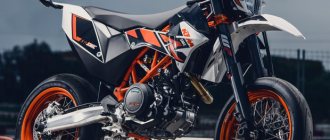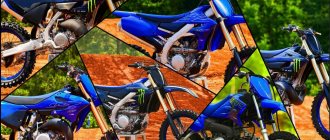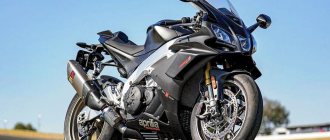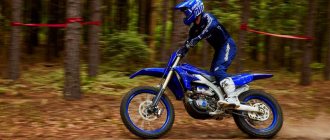Yamaha has been racing and winning since their first motorcycle rolled off the assembly line. Just 10 days after the founding of Yamaha Motor Company on July 1, 1955, the YA1, Yamaha's first model, took first place on the podium at the prestigious Mount Fuji race. Since that day, racing has become an important part of the company's heritage, and in the seven decades since then, the passion for victory has defined Yamaha's character and mission.
Whether it's a 125cc two-stroke on the side of a mountain in Japan, or cutting-edge technology in WSBK or MotoGP, the company's absolute dedication to motorsport drives it to create the most inspiring, exciting and technologically sophisticated motorcycles.
Yamaha R series
Yamaha YZF-R1M and YZF-R1 2020
Today's Yamaha R-Series sportbike segment consists of the broadest line-up of some of the most outstanding motorcycles Yamaha has ever created. Developed using the latest WSBK technology and inspired by the cutting-edge M1 MotoGP prototypes, all Yamaha R Series models from 1000cc to 125cc give thrill-seeking riders a world of ever-expanding boundaries and achieving their goals.
Racing is Yamaha's constant driving force to create industry-leading motorcycles, and for the 2021 model year Yamaha is introducing the new YZF-R1 and YZF-R1M supersport models.
Yamaha YZF-R1 2021
Yamaha YZF-R1 2020
Built to be uncompromising, the iconic YZF-R1 is Yamaha's cutting-edge supersport. Since the introduction of this innovative model, one of the most significant improvements in its history has been the introduction of the revolutionary cross-crankshaft engine in 2009. Delivering powerful, linear thrust, the new Yamaha R1 cross-crank engine transformed supersport riding, ushering in a new era in which Yamaha focused on achieving new levels of handling and rider comfort. A major breakthrough came in 2015 with the introduction of a new generation of ride-by-wire technology, allowing any rider to ride the YZF-R1 at its peak. And despite sharing the same name as its predecessors, the 2015 model is essentially an all-new motorcycle, marking the Yamaha R1's transition from the analogue to the digital world, while the introduction of an even greater array of electronic assistance in 2018 underscores the flagship model's technological prowess.
For the 2021 model year, the Yamaha YZF-R1 receives a new racing look, as well as an updated engine and improved chassis that confirm its status as Yamaha's uncompromising supersport. With its radical new design inspired by the MotoGP M1 and seven electronic assistance systems, the 2020 YZF-R1 is more than ready to race in the third decade of the 21st century.
New design of the 2021 Yamaha R1 based on the MotoGP projectile - Yamaha YZR-M1
Every Yamaha R Series model has been inspired by the YZR-M1, and the new 2021 YZF-R1 bodykit highlights the close connection between Yamaha's MotoGP and production supersports equipment.
Yamaha YZF-R1 2020
The Yamaha R1's kinship with the M1 is evident in the aggressive front fairing and wind deflector, while the sides of the new body kit flow smoothly into the tank, forming a seamless, sleek silhouette, highlighted by color-matched lower tank panels.
In addition to giving the 2021 model a more dynamic appearance and the highest quality feel, the new body kit allows the rider to get a complete feeling of oneness with the motorcycle. Aerodynamic efficiency has increased by more than 5%, giving a significant increase in performance at high speeds. And new LED headlights, along with updated LED running lights, further emphasize the novelty and character of the 2020 Yamaha R1.
The new body kit includes a new, higher-strength aluminum air duct, and the lower part of the body kit, which covers the exhaust system, is now made of titanium.
Updated Yamaha R1 engine to Euro5 standards
The 998cc inline-4 engine, producing 998cc, is one of the most exciting powertrains in the motorcycle world. This sophisticated cross-crankshaft engine delivers unparalleled efficiency and receives a number of updates for 2021 to ensure the Yamaha R1 delivers superb performance and clean emissions to meet Euro5 emissions standards.
Yamaha YZF-R1 2020
Optimized performance at high speeds
Thanks to a unique cross-shaped crankshaft with unusual flash timing of 270° - 180° - 90° - 180° and timing settings, the Yamaha YZF-R1 engine produces maximum power at 13,500 rpm, while providing a linear increase in traction throughout the entire rev range. Yamaha engineers have further enhanced the engine's outstanding high-rpm performance with new valve lifter and rocker arm designs and new camshaft cam profiles that provide optimized valve travel and more consistent valve opening and closing at high rpm, resulting in smoother, more efficient engine operation. .
Increased combustion efficiency
One of the most significant innovations is a new intake tract profile, redesigned cylinder head and repositioned injector nozzle assembly, all of which optimize engine performance. The throttle bodies have been moved closer to the combustion chambers to reduce intake tract volume, improving combustion stability and efficiency, and new Bosch injectors have been moved to the top of the 45mm throttle bodies. These 10-hole injectors deliver fuel directly to the combustion chambers and improve fuel atomization, creating a 21.5-degree spray angle that also improves combustion efficiency. In addition, among the improvements of the new model there is an updated exhaust system with four catalysts: one pair is located in front of the muffler cavity, and the second is after it. And thermal protection of the engine and muffler provides additional noise reduction.
Increased efficiency of the Yamaha R1 engine
To increase engine efficiency and reduce power loss, the crankshaft and main bearing oil passages have been enlarged, and the oil pump has a 10% more compact rotor. Other changes include re-sizing the oil passages in the crankshaft assembly to optimize oil pressure, as well as a new design for the piston cooling jets.
Other updates to the 2021 Yamaha R1 include a wider second gear for improved transmission efficiency, thicker final drive chain links, and a redesigned cylinder head coolant passage to improve exhaust port cooling.
Improved intake and exhaust systems
An important innovation in the design of the YZF-R1 power plant is a modernized cylinder head and a modified injector arrangement, which optimizes engine output. The throttle valves are located closer to the combustion chambers, which has reduced the volume of the intake pipe between the throttle valve and the valve by 12%, thereby increasing the combustion efficiency of the fuel-air mixture. New Bosch injectors are now located not at the bottom, but at the top of the throttle bodies (45 mm in diameter). These 10-nozzle injectors inject fuel closer to the combustion chambers and provide a wider (21.5º) spray angle.
The YZF-R1 exhaust system has also been upgraded, with four catalytic converters now installed - two in front of the exhaust chamber and two after it. The muffler and thermal protection received additional layers that reduce noise levels.
APSG Electronic Gas
The 2021 Yamaha R1 continues to use Yamaha's ride-by-wire throttle bodies (YCC-T), and the 2021 YZF-R1's improved throttle response is provided by a new APSG (sensing throttle) system with a magnet and sensor that sends signals to the YCC -T. To maintain the intuitive feel of a conventional cable-operated throttle, the new APSG system features a spring, slider and pinion to provide a natural and progressive throttle feel, and this mechanical feedback is tuned to provide increased control and enhanced rider-bike interaction.
Higher efficiency
To improve engine efficiency and reduce power losses, the diameter of the main bearings was increased, as well as the diameter of the oil lines inside the crankshaft. The oil pump rotor size has been reduced by 10%. Also, to optimize the pressure in the lubrication system, the dimensions of the oil lines in the crankcase parts were changed and the design of the nozzles that inject oil under the piston heads was modernized.
Other changes for the 2021 season include wider second gears and stronger final drive chain plates. Also, for improved cooling of the exhaust tract, the design of the cooling channels in the cylinder head was changed.
Suspension with improved feedback
The excellent 43 Kayaba fork with 120mm of travel is considered one of the best in its class, and its internal design has been tweaked to improve feedback. New smoothing valves are mounted in a laminated assembly and this - together with slightly reduced spring rates and new fork oil levels - provides more precise road feedback for a more precise and natural steering feel. In addition to these changes, suspension updates include a new steering damper and new rear shock settings.
Brakes and road stability
The Yamaha YZF-R1's twin front 320 disc brakes with monobloc calipers are widely known for their excellent feedback and excellent braking performance. For the 2021 model, they feature new pads with an increased coefficient of friction, providing even more powerful braking. Also, the wheels of the new model are shod with new rubber - Bridgestone Battlax RS11, which provides excellent grip and precision control, allowing the rider to get the most out of the motorcycle.
More control
As before, the Yamaha YZF-R1 uses a fly-by-wire throttle control system, but to improve feedback and reduce weight, the new product uses an advanced APSG (Accelerator Position Sensor Grip) system, which includes a magnet, gears, a spring and a special sensor. , sending signals to the control unit. Such a system provides a high level of control and interaction between the driver and the machine, which is critical for a device designed, among other things, for sports use.
Yamaha R1 Electronic Control Systems
The Yamaha YZF-R1 is the first motorcycle to be equipped with next-generation artificial intelligence in the form of a 6-axis inertia measurement device. Equipped with a gyroscopic sensor and a gravity sensor to track position in three axes, as well as an accelerometer to track acceleration along these axes, the inertia measurement unit transmits information about the motorcycle's position 125 times per second to the driver-assist control unit.
For the 2021 model year, the Yamaha R1 receives two significant enhancements to its electronic driving aids, further enhancing the model's outstanding track potential.
New Brake Control with Inclined ABS
2020 Yamaha YZF-R1
The new BC system allows the R1 rider to choose between two ABS operating modes, BC1 and BC2. Mode BC1 provides a fixed level of ABS sensitivity, and in mode BC2, ABS sensitivity depends on the angle of inclination and other features of the motorcycle’s position in space. In this mode, ABS sensitivity and intervention levels increase as the bike's lean angle increases, providing greater confidence in safe cornering braking. Data on the rotational speeds of both wheels, as well as information from the inertia measuring device, such as lean angle and sliding acceleration, are transmitted to the hydraulic module and the ABS electronic control unit, where calculations are carried out in real time. This information allows the BC system to prevent wheel locking by modulating the brake fluid pressure in the front and rear brake circuits.
New Engine Brake Management (EBM)
Another innovation in the 2021 Yamaha YZF-R1 is the Engine Brake Control system, which allows you to select one of three levels of engine braking force (high - medium - low) according to the situation and personal preference. This system uses data from a variety of sensors, including gear, engine speed, throttle position and throttle, which are processed by the ECU to adjust throttle opening, ignition timing and fuel volume to influence engine braking. EBM1 provides the maximum level of engine braking, while EBM3 provides the minimum level.
Modified Launch Control System (LCS)
The Yamaha YZF-R1 Launch Control system provides additional control over the motorcycle when starting, and for the 2021 model its LCS1 mode has been modified, activating at 9000 rpm at 41 degrees of throttle opening.
With the introduction of Brake Control and Engine Brake Control, as well as enhanced launch control, the 2021 Yamaha YZF-R1 features seven different electronic assist and control systems, providing riders with supreme confidence and control in a wide range of situations. Each electronic system has been designed to integrate seamlessly with the rest, providing a natural and intuitive feel to enable every rider to reach their full potential.
Advanced Electronics
At one time, a revolution in the world of road sports motorcycles began with the Yamaha YZF-R1: after all, this model was the first to receive an advanced 6-axis inertial measurement unit (IMU). Its gyroscopes and sensors measure acceleration along three coordinate axes and torque around these axes. The received data is transmitted 125 times per second to the control unit, which controls all electronic assistants. The new YZF-R1 has two more advanced electronic systems that increase the machine's potential on the track.
Features of the 2021 Yamaha YZF-R1
- Aggressive M1-style front fairing
- Fully integrated body kit for improved rider-bike connection
- 5% increased aerodynamic efficiency
- Updated suspension characteristics for better feedback
- New brake control system with two ABS modes
- New engine braking control system with three modes
- Optimized launch control system
- New electron gas
- Increased combustion efficiency and performance at high speeds
- Improved performance of braking systems
- New steering damper settings
- The latest Bridgestone Battlax RS11 tires
- New LCD instrument panel with BC and EBM indicators
- Econorm Euro5
2020 Yamaha YZF-R1
Engine Brake Management
The second new addition to the YZF-R1's impressive suite of electronic aids is Engine Brake Management, or EBM. The driver can choose from three engine braking modes (maximum – medium – minimum), suitable for different operating conditions of the motorcycle. Using data from various sensors (selected gear, engine speed, throttle position and throttle grip), the control unit regulates throttle opening, ignition timing and the amount of fuel injected, influencing the degree of engine braking. Mode EBM1 corresponds to the highest degree of engine braking, mode EBM3 corresponds to the least.
Key Features of Yamaha YZF-R1
- 998 cc 4-cylinder cross-crankshaft engine producing 200 hp.
- Linear thrust characteristic
- Advanced electronic assistance systems
- 6-axis inertia measurement system with gyro and gravity sensor
- Customizable engine thrust modes (PWR)
- Traction Control (TCS) and Slide Control (SCS) with tilt tracking
- Front lift control (LIF) and launch control (LCS)
- Quickshifter (QSS)
- Short wheelbase diagonal aluminum frame Deltabox
- Raised beam pendulum
- Magnesium rear subframe
- Colors: Yamaha Blue DPBMC, Tech Black SMX/MBL2
The 2021 Yamaha YZF-R1 will go on sale in September 2019.
Launch Control System
The Launch Control System (LCS) used on the Yamaha YZF-R1 allows you to start racing more confidently. For the 2020 season, engineers retuned the LCS1 mode, and now it comes into effect at 9000 rpm, when the throttle valves are open at 41º.
Featuring BC and EBM systems and a modified LCS, the new 2021 Yamaha YZF-R1 now features seven electronic driver aids that give the rider a sense of confidence and control in a wide range of road and track conditions. Each electronic system is designed to be deeply integrated with other aids, allowing the pilot to realize his full potential.
Yamaha YZF-R1M 2021
Yamaha YZF-R1M 2020
The Yamaha YZF-R1M is Yamaha's most advanced supersport and has a well-deserved reputation as one of the most sophisticated and powerful racing motorcycles not only for professional athletes, but for all enthusiasts who do not accept compromise.
With its advanced electronics and aggressive carbon body kit inspired by the M1's exterior, this exceptional race bike offers every rider the opportunity to experience the true power of a factory superbike. Moreover, thanks to its advanced CCU and Ohlins Electronic Racing Suspension (ERS), racers have the opportunity to have the perfect engine and chassis package tuned to work together optimally without the need for additional investment. This in turn gives a wide range of riders a real chance to discover their true potential in one of the best extreme sports.
The 2021 Yamaha YZF-R1M receives a number of exclusive updates in addition to all modifications to the base YZF-R1 model
New Ohlins ERS NPX fork with gas boost
The Yamaha YZF-R1M features the latest generation of Ohlins Electronic Racing Suspension (ERS), providing the highest level of adjustability for ultimate control and outstanding performance.
The 2021 Yamaha R1M gets the latest version of the Ohlins ERS NPX gas-assisted fork. It is equipped with a small gas cylinder built into the wheel axle holder, and thanks to the internal gas pressure of 0.6 MPa, foaming of the fork oil that occurs during the rebound stroke is suppressed.
The new Ohlins ERS NPX gas-assisted fork significantly improves smoothing stability, increasing chassis control along with light steering, thereby reducing lap times.
In addition to the new fork, the Ohlins electronic rear suspension has received an updated preload setting.
Yamaha R1M's New Lightweight Carbon Tail
New to the 2021 Yamaha R1M is a lightweight carbon tail cone, complementing the M1-style front fairing and fender. The use of an extremely lightweight body kit underlines the exclusivity of the YZF-R1M and contributes to the motorcycle's extremely low weight and excellent handling.
Unique instance number
The Yamaha YZF-R1M is without a doubt the most unique supersport model in the Yamaha line-up. To make ownership of this motorcycle even more unique, Yamaha has individually numbered each piece.
YZF-R1M Apps: Yamaha Virtual Mechanics!
Yamaha have developed a range of applications for the YZF-R1M, giving any rider full access to the sophisticated technology available to the factory teams. The intuitive interface makes these apps an indispensable and convenient tool for instantly configuring Yamaha's advanced electronic driving aids, allowing you to customize your motorcycle just like the factory mechanic team!
YRC Setting App
This app allows users to create their own personalized driving modes, incorporating settings from all seven electronic assistance systems. Yamaha R1M riders will be able to choose a convenient level of assistance for each mode, and in some cases will have the opportunity to disable one or another electronic assistance. The system is fast and easy to use and gives users the ability to fine-tune the bike to suit their skills, style and riding conditions.
Y-TRAC app
Y-TRAC is Yamaha's Telemetry Recording and Analysis Controller. It allows users to access the CCU (Communication Control Unit) of the motorcycle and read a range of data from it. Thanks to this application, it is possible to view and reproduce trip logs in real time on a track image from Google Maps, as well as analyze and compare all parameters from engine speed and inclination angles to accelerations and records of activation of electronic assistance devices.
Driving impressions
Yamaha YZF-R1
While the Yamaha R1 may not have the prestige of some European competitors, it is still one of my favorite sportbikes (on the track, of course. On the road it's a pain). Few models can compete with the divine melody of the R1's offset ignition when it sings in full voice, and with the new electronic throttle the engine response to the throttle has become even better - essentially, which is the point of the cross-shaped crankshaft.
If you're familiar with the latest Yamaha YZF-R1, the 2021 model won't seem too new. Starting the day with the base model, I quickly felt familiar and comfortable, even though I hadn't driven one in a couple of years. And I hadn’t been to this track for more than 10 years, so I started with a familiarization lap, which the R1 did very well.
Let me note a few points.
First, I already talked about this - I really appreciated the instant response of the rear wheel to movements with my right hand. The Yamaha YZF-R1 produces great traction, but it's completely controllable (assuming you're not a beginner - the R1 is definitely not for beginners). Yamaha representatives didn't point this out, but the revs, especially in riding modes 1 and 2 (the two most bouncy and powerful), are much smoother than on other Yamahas I've tested. Personally, I preferred mode 2 for its slightly less aggressive kick at the start.
Yamaha YZF-R1 2020
The second thing is damn nice confidence in every sense: the Bridgestone R11 corners superbly (the stock R1s will be shod with RS11s) at any angle available to me, and the feedback is clear and understandable both from the tires and from the chassis as a whole.
Third, I relied on electronic assistants, and they did not disappoint. Ten years ago, when I last visited this track, I was riding a Ducati 1098R with the first traction control fitted to a production motorcycle. And although this was a nice bonus, it was more of a road bonus - on the track it interfered too obviously and tediously, constantly cutting off traction and making it difficult to complete the lap as quickly as possible. Ten years later, the electronic features on the Yamaha R1 are barely noticeable. This is the best evidence of how far we have come, and it makes us look forward to the further development of these technologies.
At the end of my third and final ride (which was the sixth for the bike, since we alternated in the saddle), I felt that I began to ride confidently, but the bike, on the contrary, was tired. Or rather, the tires are tired: the side support has dropped considerably. In one of the simple corners, it was necessary to open the gas as early as possible in order to get out of it as quickly as possible onto the straight, but on worn tires this led to a serious breakdown - and I would be happy to say that my skills saved me, but praise the perfect work of the traction control. control will be more honest.
Yamaha YZF-R1
Thinking back to 2015, when the first version of today's Yamaha R1 first appeared, I can clearly imagine how the adjustable wheelie control allowed the front wheel to rise under load and then smoothly return to the track. Everything remains roughly the same on the Yamaha YZF-R1 in 2021, and you especially feel it coming out of the narrow hairpin at the end of the lap. You come out of the last corner at full throttle, and really ride on the back foot. The lift control works, and you can directly feel how it is trying to figure out how much traction to provide so that you move forward, but not lift the front wheel too much. I shift up and the front lands. Personally, being able to use the gas without fear gives me a kind of serenity that allows me to go faster. It should be noted that I was driving in lift control mode No. 2. The first mode leaves the rider more control, and the braver guys I've talked to turn off the lift control altogether and work with their head, not just their right hand.
If we talk about the weak points of the Yamaha R1, then these are again the brakes. Braking power is decent and response is better, but I want more. More braking force, more sensitive initial braking and LESS ABS! Sometimes heavy braking and three quick downshifts activate the ABS for no apparent reason, especially on the rear wheel, which once forced me to go very wide and completely miss the turn.
Yamaha R1M
Yamaha R1M
I switch to the Yamaha R1M saddle on Bridgestone V02 slicks this afternoon and the impressions are... basically the same. This shouldn't be surprising, given that the main difference between the two is in the suspension. However, there is still a noticeable difference between conventional and semi-active suspension: when you load the fork with powerful braking, you feel how the electronic suspension reacts and adjusts, providing greater stability and support during braking. And all this - in a split second. The same goes for the rear suspension during acceleration.
The real difference in sensations begins when you get off the Yamaha R1M and start downloading telemetry logs. In the application on your phone you can see a huge number of parameters for driving each circle. There are 16 different data layers that show throttle percentage, GPS speed, gear engaged, and where and when the driver's aids were engaged, all overlaid on a graph and Google Maps track map. This truly is a new level of analysis for those outside of the factory racing teams.
Yamaha R1M 2020
Features of Yamaha YZF-R1M 2021
- Ohlins ERS NPX fork with gas boost
- Lightweight carbon tail fairing
- Aggressive carbon body kit in M1 style
- A unique copy number is printed on the body kit
- Updated Y-TRAC and YRC applications
- Fully integrated body kit for improved rider-bike connection
- 5% increased aerodynamic efficiency
- New brake control system with two ABS modes
- New engine braking control system with three modes
- Optimized launch control system
- New electron gas
- Increased combustion efficiency and performance at high speeds
- Improved performance of braking systems
- New steering damper settings
- The latest Bridgestone Battlax RS11 tires
- New LCD instrument panel with BC and EBM indicators
- Econorm Euro5
Yamaha YZF-R1M 2020
Key Features of Yamaha YZF-R1M
- Electronic Racing Suspension (ERS) Ohlins
- Exclusive design with carbon and polished components
- Carbon front fender
- Communications Control Unit (CCU) with wireless configuration capabilities for multiple motorcycle parameters
- 998 cc 4-cylinder cross-crankshaft engine producing 200 hp.
- 6-axis inertia measurement system with gyro and gravity sensor
- Customizable engine thrust modes (PWR)
- Quickshifter (QSS)
- Traction Control (TCS) and Slide Control (SCS) with tilt tracking
- Front lift control (LIF) and launch control (LCS)
- Short wheelbase diagonal aluminum frame Deltabox
- Raised beam pendulum
- Magnesium rear subframe
- Exclusive access to European Yamaha Racing Experience events
- Colours: Silver Blu Carbon BWM2, Carbon
Yamaha YZF-R1M 2020
Pre-order system for YZF-R1M 2020
Yamaha will begin accepting online pre-orders for the YZF-R1M on July 25, 2019. Users will have the opportunity to choose a convenient dealership.
Yamaha Accessories
Yamaha offers a wide range of factory accessories for the YZF-R1 and YZF-R1M, including beautiful aluminum components, power upgrades, mufflers and service components, as well as exclusive, easy-to-install accessories to personalize your sportbike.
Yamaha YZF-R1M and YZF-R1 2020
Riders looking for extra power will be interested in the Akrapovic exhaust system, specially created for the Yamaha YZF-R1 and YZF-R1M. This exhaust has a more aggressive sound, high-quality titanium construction and is fully Euro5 compliant. A special track version of the Akrapovic exhaust will also be available to fully realize the engine's potential.
The line of factory accessories also includes various versions of wind deflectors, sliders and other components to style and protect the legendary Yamaha R1 sportbikes. New products are constantly being developed and the Yamaha Genuine Accessories website is updated as they are released. At the moment, the compilation of a new line of Accessory Packs for R series models is being completed, detailed information about which will appear at the end of 2019.
Yamaha YZF-R1M and YZF-R1 2020
So, what is next?
When discussing flagship sportbike models, we always say this, but how can we remain silent...
So what's next? What innovations await us in the next releases? With the R1 and R1M, Yamaha took its already excellent litrosport and added small but useful improvements to it. I'm almost ready to call him the favorite in his class, and certainly the best among the Japanese. This is the kind of bike that makes going fast easy, if there is one in its category. Plus, it sounds great.
Both versions will hit showrooms in October-November 2021, with the M model available for pre-order in limited numbers on Yamaha's official website.











